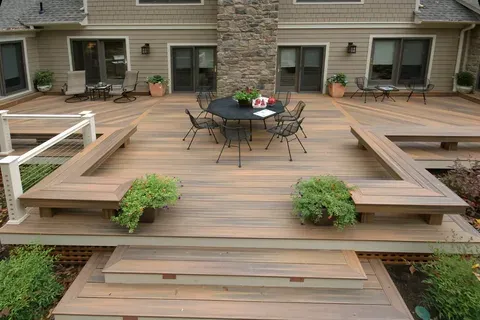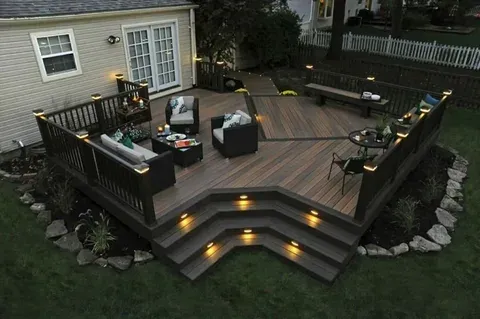Decking has evolved into one of the most desirable outdoor features for homes worldwide. Whether you're aiming to create a cozy space for morning coffee, a stylish entertainment area, or a peaceful backyard retreat, the right decking can completely transform your outdoor living experience.
In 2025, decking continues to be a smart investment that boosts both functionality and curb appeal. From modern materials to eco-friendly designs, this guide will walk you through the essentials of decking and how to choose the best fit for your lifestyle.
Why Decking Is the Heart of Outdoor Living
Decking offers a seamless transition from indoor comfort to outdoor enjoyment. It provides a versatile platform where you can host gatherings, lounge in the sun, or dine under the stars. More importantly, a well-designed deck adds real value to your home.
Here’s why homeowners are prioritizing decking:
Increases property value
Enhances aesthetics
Provides usable outdoor space
Customizable for all budgets and sizes

Types of Decking Materials: Pros and Cons
When choosing decking, material is one of the most critical decisions. Let’s explore the most popular options available in 2025:
1. Wood Decking
Pros: Natural look, easy to stain or paint, widely available
Cons: Requires regular maintenance, prone to rot and termites
Popular wood types include cedar, redwood, and pressure-treated pine.
2. Composite Decking
Pros: Low maintenance, long-lasting, resistant to rot and insects
Cons: Higher upfront cost, may retain more heat in the sun
Made from a mix of wood fibers and plastic, composite decking is perfect for modern homeowners who want durability without constant upkeep.
3. PVC Decking
Pros: Completely waterproof, fade-resistant, minimal maintenance
Cons: Can be slippery, limited color variety
This synthetic option is ideal for wet climates or poolside areas.
4. Aluminum Decking
Pros: Fire-resistant, lightweight, recyclable
Cons: Expensive, industrial look
Aluminum decking is becoming increasingly popular in commercial and contemporary residential settings.
Design Trends for Decking in 2025
Stay ahead of the curve by integrating some of the hottest design trends:
Multi-Level Decks: Create zones for cooking, lounging, and dining.
Built-In Seating and Planters: Combine function and form effortlessly.
Smart Lighting: Solar and LED lights add ambiance and safety.
Sustainable Materials: Go green with reclaimed wood or recycled composites.
Mixed Textures and Colors: Contrast materials like wood and stone for a unique look.

Planning Your Decking Project
A successful decking project begins with good planning. Follow these steps:
Set Your Budget
Identify what you can afford, including materials, labor, and extras like lighting or furniture.
Choose the Right Material
Consider your climate, maintenance preference, and aesthetic vision.
Think About Usage
Will the deck be used for large parties, quiet mornings, or dining with family? Your usage determines the size, shape, and features.
Hire a Professional
Even if you're a DIY enthusiast, a consultation with a decking contractor can ensure safety and durability.
Deck Maintenance Tips
To keep your decking looking its best for years to come:
Clean regularly with a deck brush and cleaner
Seal wood decks every 1-2 years to prevent moisture damage
Check for loose boards or nails
Avoid using rugs or mats that trap moisture
Composite and PVC decks require less maintenance but should still be cleaned to prevent mildew and staining.
Conclusion
Whether you’re planning a new build or upgrading an old deck, investing in quality decking is one of the best ways to elevate your home's outdoor appeal. From material selection to design trends and maintenance tips, this guide offers everything you need to create a stunning, long-lasting deck.
FAQs
1. What is the best decking material for low maintenance?
Composite decking is considered the best low-maintenance option due to its durability and resistance to mold, rot, and insects.
2. How long does a wooden deck last?
With proper care and sealing, a wood deck can last anywhere from 10 to 20 years, depending on the type of wood used.
3. Can decking be installed over concrete?
Yes, most decking types can be installed over concrete patios using sleepers and a proper frame system.
4. Is composite decking eco-friendly?
Many composite decking brands use recycled wood fibers and plastic, making them a more sustainable choice than some traditional wood options.
5. How do I prevent my deck from becoming slippery?
Regular cleaning, anti-slip coatings, and choosing textured materials like grooved composite boards can help reduce slipperiness.